Biodiversity protection in global context
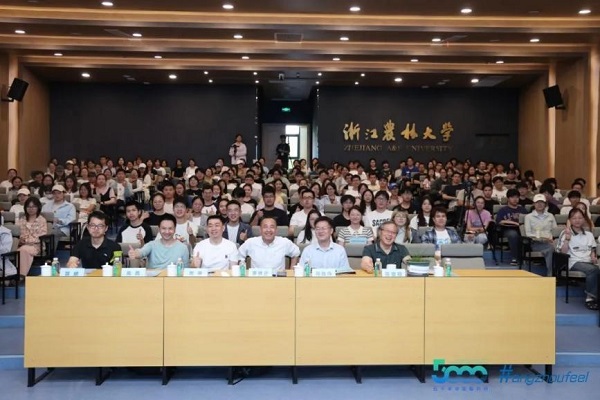
Packed to the rafters: A group photo of the participants.
What are the concepts and basic levels of biodiversity? How long is the process of discovering a new species? And what inspires a photographer to cross over into the world of fungi and become a science communicator? The session on biodiversity left participants eager to contribute to conservation efforts themselves.
May 22 marked the International Day for Biological Diversity. To celebrate this special day, the Hangzhou International Communication Center, in collaboration with the News Center of Zhejiang A&F University, launched the third event in the "Hangzhoufeel Training Program" — Biodiversity and Global Expression.
Hosted by the School of Forestry and Biotechnology of Zhejiang A&F University, the event invited three experts and professionals in the field of biodiversity to share inspiring, hands-on insights that blended theory with practice, engaging over 200 students from the university.
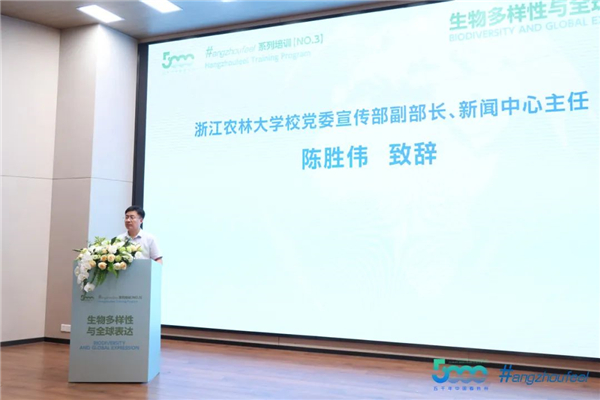
Chen Shengwei delivers his speech.
In his opening remarks, Chen Shengwei, director of the News Center and Deputy director of the Publicity Department of the Party Committee at Zhejiang A&F University, made important points. He emphasized that as a university with strong disciplines in agriculture, forestry, biology and environmental science, Zhejiang A&F University had always regarded biodiversity conservation as a key part of ecological civilization education of its students and faculty.
Over the years, the university has nurtured a large number of contributors and advocates dedicated to biodiversity protection and ecological development. As the university is located within the Tianmushan-Qingliangfeng Biosphere Reserve in Zhejiang province, it bears both the responsibility and the mission to contribute wisdom and strength to the 5th World Congress of Biosphere Reserves.
Chen hoped that through this training session, students would be guided into the fascinating world of biodiversity conservation, broaden their global perspectives and help bring greater international recognition to Hangzhou's and China's achievements in protecting biodiversity.
Value of biodiversity goes far beyond continuation of species
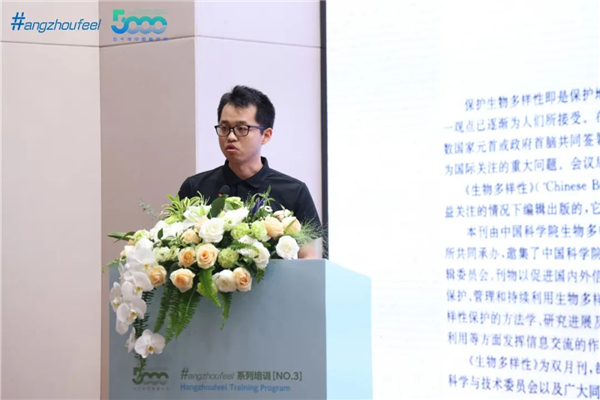
Zeng Di explains the importance of biodiversity.
What is biodiversity and why is it so highly valued? What happens to our planet if biodiversity is lost — and what can we actually do to protect it in practice? Zeng Di, a lecturer at the School of Forestry and Biotechnology of Zhejiang A&F University and a dedicated researcher in the field of biodiversity, tackled these questions in depth.
Starting with the concept itself, he used clear, real-life examples to help students better understand the significance of biodiversity conservation.
"From a human perspective, the food we eat, the water we drink and many raw materials we depend on all come from nature — and all rely on biodiversity," Zeng explained. "According to some studies, the biosphere as a whole provides services valued at $33 trillion each year," he added.
Zeng emphasized that biodiversity isn't just about tangible resources like food, tourism and education — it also plays vital indirect roles in regulating climate and processing pollution. In addition, its value also lies in the existence and potential use of species, genes and ecosystems.
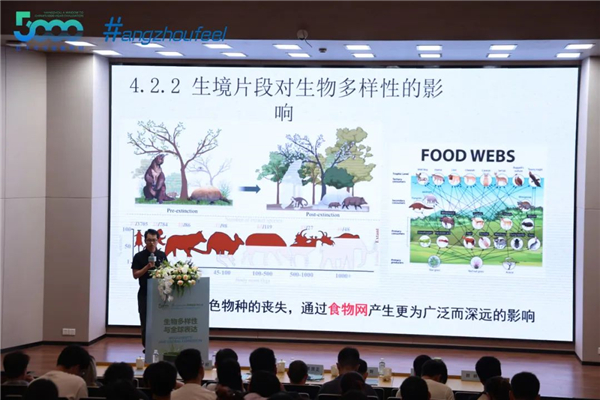
Zeng Di talks about biodiversity.
Equally, the loss of biodiversity poses serious threats to ecosystems and the very future of humanity. That's why the practice of conservation has become one of the most crucial areas of research today.
Key achievements in this field include the creation of protected area systems, the establishment of China's Biodiversity Monitoring and Research Network (Sino BON), advances in theoretical studies, the protection of threatened species and critically small populations, recovery efforts for endangered species worldwide and the ongoing work of biodiversity cataloging.
One especially powerful case Zeng highlighted was the conservation success story of the crested ibis or Nipponia nippon. "The crested ibis is a classic example of how China has contributed to global endangered species recovery," he said.
"With the rise of human activity, their habitat shrank drastically. In response, our ecologists and biologists launched a series of protection efforts — including artificial breeding programs and reintroduction into the wild — which helped the wild population grow from just seven birds to over 10,000," Zeng added.
However, biodiversity conservation continues to face numerous challenges. Zeng illustrated potential future trends in global biodiversity using data visualizations: "According to existing research, if we maintain our current investment in biodiversity conservation while also adopting sustainable production and consumption models, we could see biodiversity begin to recover — and even improve — by 2050. But if we do nothing, biodiversity as we know it could collapse."
His stark message came alongside the global context of the UN Biodiversity Conference (COP15) and the launch of the Kunming-Montreal Global Biodiversity Framework, which has inspired countries worldwide to step up their efforts in protecting the planet's biodiversity.
Zeng concluded by highlighting how everyday people can also take part in this global cause: "Even non-experts can contribute to biodiversity conservation by participating in citizen science projects, helping to collect essential baseline data that supports both national and global biodiversity efforts."
"It's not chives or scallions!" The discovery of Isoetes

Chen Yuchu shares his story about the Isoetes discovery.
"To make a science video about Isoetes, I spent 5 yuan on a bunch of chives — and the scallions were from my own backyard," said Chen Yuchu, drawing laughter from the audience. Chen, President of the Hangzhou Aquatic Plants Society and discoverer of two nationally protected plant species, wasn't just here for laughs — he brought along a living specimen of Isoetes yuhangensis, a rare plant he discovered and cultivated, to share the story behind this remarkable find.
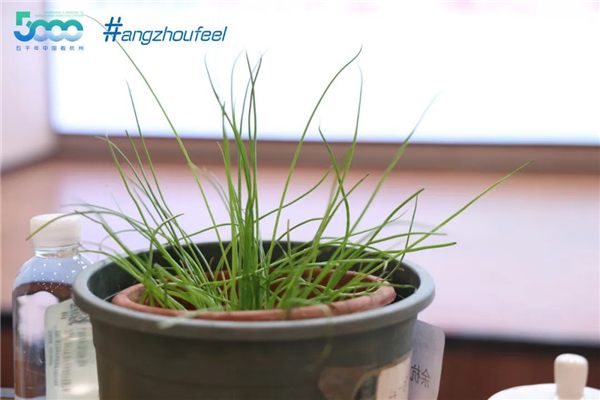
An example of Isoetes yuhangensis.
From 2005 to 2021, Chen was tirelessly chasing the trail of Isoetes. When he heard a rumor that someone might have seen the plant, he'd travel to the site himself.
Despite numerous false leads and fruitless trips, he never gave up. After more than a decade of field research and species hunting, he officially announced the discovery of two new species of wild plants under first-class national protection in China: Isoetes changleensis and Isoetes yuhangensis.
However, the challenge didn't end with the discovery. Chen also faced the issue of habitat preservation. At the training session, he presented a series of comparison photos showing how the aquatic environment of the Isoetes population in Lin'an had deteriorated year by year.
These images precisely illustrated how shrinking water levels and habitat degradation have squeezed the plant's living space. Chen has conducted numerous field investigations, meticulously documenting critical data like water levels necessary for the plant's survival.
For these newly discovered species, Chen stressed that in-situ conservation alone is not enough. Artificial propagation is essential, along with widespread science education and strong media support to raise public awareness about the protection of wild species.
"The fact is that the holding of the UN Biodiversity Conference in Kunming and the holding of the 5th World Congress of Biosphere Reserves in Hangzhou this September proves that China has made significant achievements in protecting natural resources. We can play an even greater role in safeguarding biodiversity for all of humanity in the future," he added.
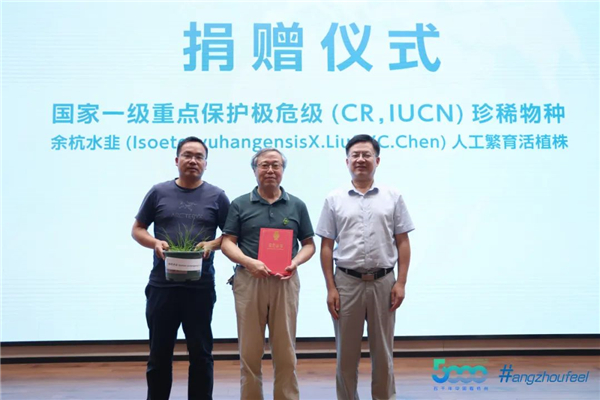
The Isoetes yuhangensis donation ceremony takes place.
At the end of his talk, Chen Yuchu donated a potted, artificially propagated Isoetes yuhangensis plant to Zhejiang A&F University, where it will serve both scientific and educational purposes.
From photographer to fungi science communicator: A cross-disciplinary journey fueled by passion
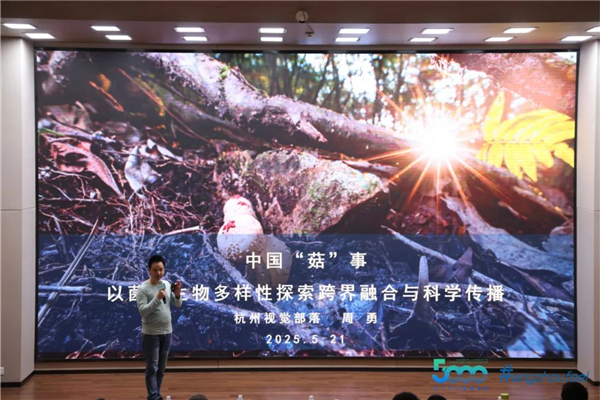
Zhou Yong provides fascinating information about mushrooms to his audience.
As the founder of the Hangzhou Visual Tribe, Zhou Yong is best known to the public as a photographer, creative planner, or documentary director. But then, this visual artist crossed over into the world of fungi to become a science communicator and brought out a raft of fascinating "fungi stories".
"From a scientific perspective, fungi play three key roles in ecosystems: They're decomposers, symbionts and balancers," Zhou explained, while showing a short video his team filmed of fungi decomposing an animal carcass.
"This particular video took nine days to shoot and it clearly captures the entire decomposition process. With short videos like this, viewers can really grasp how fungi function," he said.
Zhou also shared a little-known economic fact: Around 70-80 percent of counties in China that successfully escaped poverty did so with the help of the mushroom industry. Compared to cultivating Chinese medicinal herbs or fruit, edible fungi yield faster returns and earlier economic benefits.
In contrast to text, Zhou's documentary Kingdom of Fungi blends academic insight, scientific popularization, storytelling and cinematography to vividly portray why fungi are indispensable to the ecological cycle.
As the first comprehensive documentary in China dedicated to fungal biodiversity, Zhou's team spent two years filming deep in primeval forests. With academic advisors guiding the project, Zhou gradually became something of a fungi "expert" himself.
To capture the unseen, Zhou employed a wide range of advanced filming techniques — including time-lapse, macro/probe photography, drone footage, slow-motion and even a pioneering microbial filming method — to bring every movement of fungi vividly to life.
He shared behind-the-scenes stories from the field: "There was a kind of symbiotic fungi that can only be filmed in the wild at elevations above 1,500 meters. It got very cold when it rained and the fungi grew extremely slowly. It took over 20 days to mature — but once you start shooting, you can't stop, or the footage won't be continuous," he recalled.

Zhou Yong recalls a story about his special documentary.
After finishing the documentary, Zhou's team went on to conduct biodiversity field research. In 2024, they collected 463 specimens from four plots in the Baishanzu National Park. So far, 243 have been identified, including seven new species of Mycena and several new lichen species.
Their work is not only helping to build a genetic resource database for biodiversity, but is also using short videos and photos to showcase China's fungal biodiversity to a global audience.
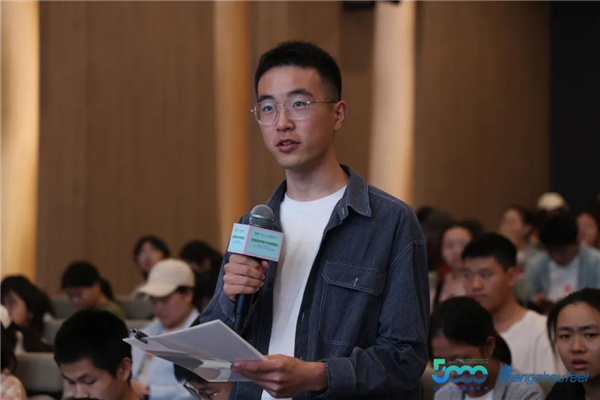
Members of the audience ask the lecturers searching questions.
Zhou said his original motivation was simple: His love of fungi. But he also stressed the importance of choosing topics and pushing creative boundaries.
"You have to dive deep into the field and only with truly compelling content can you engage your audience and tell China's fungi stories in a meaningful way," he said.
Many students at the session, though from forestry or agricultural science backgrounds themselves, said this was their first time experiencing a presentation that so effectively combined field expertise with creative media.
One student remarked that Zhou's talk resolved many long-standing questions and inspired them to build on their academic foundations and someday contribute to nature documentaries themselves.
-
Visionary Pathway - Hangzhou Playbook
July 15, 2025



